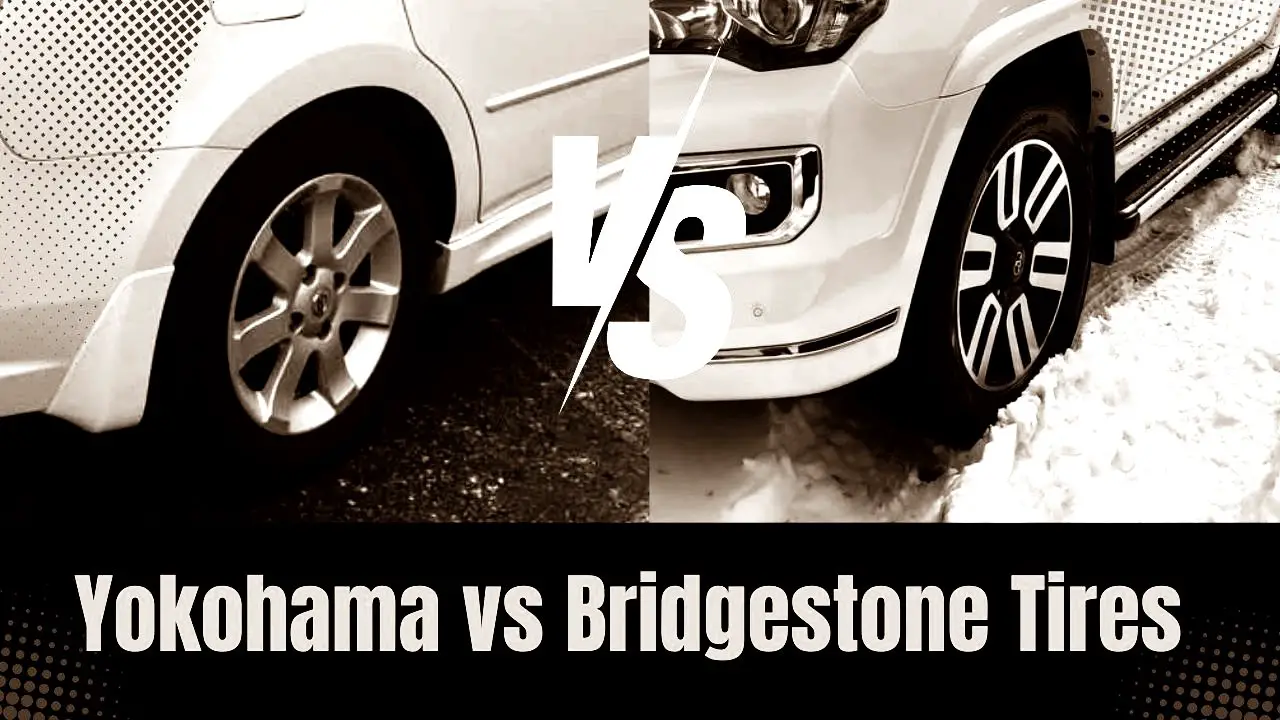Bridgestone Blizzak WS90 vs Yokohama Ice Guard IG53

Winter driving can transform even the most familiar roads into treacherous obstacle courses, where the right tires become your first line of defense.
Among the top contenders for conquering snow, ice, and slush are the Bridgestone Blizzak WS90 and the Yokohama Ice Guard IG53—two studless winter tires engineered to keep you safe when the temperature plummets.
But which one deserves a spot on your vehicle? In this detailed comparison, we’ll explore their strengths and weaknesses, from icy highways to snow-drenched backroads, to help you decide which tire aligns with your winter driving needs.
Yokohama vs Bridgestone Tires
Below is a table chart comparing the Bridgestone Blizzak WS90 and Yokohama Ice Guard IG53.
| Feature | Bridgestone Blizzak WS90 | Yokohama Ice Guard IG53 |
|---|---|---|
| Mileage Warranty | None offered, typical for winter tires. | None offered, standard for this category. |
| Price | Around $180 for 205/55R16, steady across retailers. | $150 to $250 for 205/55R16, varies by source. |
| Tire Type | Studless winter, suits passenger cars and minivans. | Studless winter, fits compacts, sedans, minivans. |
| Rim Range | Covers 15 to 19 inches, great for larger vehicles. | Spans 14 to 18 inches, ideal for smaller rides. |
| Tread Pattern | Closed design with V-notches, excels on ice, not snow. | Aggressive directional tread, clears snow like a pro. |
| Off-Road | Sticks to paved roads, no off-road chops. | Paved roads only, not built for trails. |
| On-Road | Rules ice, wet, and dry, with better braking and efficiency. | Tops fluffy snow, lags on ice and fuel savings. |
| Expert Opinion | SnowyTires loves it for ice and mixed conditions. | SnowyTires picks it for snow traction in deep drifts. |
| Our Observation | Best for icy, mixed roads, rims up to 19 inches. | Perfect for snowy zones, smaller rigs up to 18 inches. |
Price and Availability
Let’s start with the practical stuff: your wallet. For a common tire size like 205/55R16, the Bridgestone Blizzak WS90 hovers around $180, based on listings from retailers like Amazon.
The Yokohama Ice Guard IG53, meanwhile, fluctuates between $150 and $250, according to 1010Tires. Neither tire comes with a mileage warranty—a standard omission for high-performance winter rubber—meaning your investment hinges on performance rather than longevity promises.
While prices vary by retailer and region, the two are close enough that cost alone won’t tip the scales. It’s what they deliver on the road that matters.
Tire Type
Both tires fall into the studless winter category, meaning they rely on advanced rubber compounds and tread designs rather than metal studs to grip the road.
The WS90 fits rim diameters from 15 to 19 inches, making it a versatile choice for everything from compact sedans to larger crossovers. The IG53, with a range of 14 to 18 inches, caters more to smaller vehicles like compacts and coupes but still suits most minivans.
If your ride sports larger rims, the WS90 offers a slight edge in compatibility. Otherwise, both tires align with typical winter-ready vehicles.
Tread Patterns
A tire’s tread is its handshake with the road, and these two shake hands differently. The Blizzak WS90 sports a closed tread design, lacking the interlocking grooves you might expect in a snow specialist.
Instead, it uses intricate biters and V-shaped notches to dig into ice and maintain stability on wet or dry pavement. This makes it less adept at clearing deep, fluffy snow but a champ on harder surfaces.
The Yokohama Ice Guard IG53, by contrast, flaunts an aggressive directional tread with wider grooves and lateral siping. This setup excels at shoveling snow and water away, giving it an advantage in powdery drifts.
However, those same broad voids can compromise stability on ice or dry roads, where precision matters more than evacuation. Your local weather forecast might just dictate which pattern suits you best.
On-Road Performance
Winter tires live or die by their on-road prowess, and here’s where the WS90 and IG53 start to diverge.
- Snow Traction: If fluffy, fresh snow is your nemesis, the IG53 steps up. Its aggressive tread bites into soft snow, providing superior traction where the WS90’s closed design falters. For packed snow, both perform admirably, but the IG53 shines in deeper drifts.
- Ice Grip: On ice, the WS90 takes the lead. Testing reveals it stops 15 feet shorter than competitors like the IG53, thanks to its detailed siping and biting edges. For drivers facing black ice or frozen intersections, this could be a game-changer.
- Wet Conditions: Rain-slicked winter roads favor the WS90 again, with dual siping structures that wipe water away efficiently. The IG53 holds its own against hydroplaning at speed, but its lateral-only siping can’t match the WS90’s versatility.
- Dry Handling: Surprisingly, dry winter roads aren’t a wash. The WS90’s continuous running rib delivers crisp steering, shorter braking, and quicker acceleration. The IG53, with its wider grooves and softer rubber, sacrifices some steering feedback and stability here.
- Comfort and Efficiency: The WS90 rolls quieter and smoother, while its lighter build boosts fuel economy—a bonus for long commutes. The IG53, heavier and noisier, cushions bumps better but guzzles more gas due to increased friction.
Off-Road Potential: A Limited Scope
Neither tire is built for off-road adventures, with manufacturer specs and reviews focusing solely on paved surfaces.
If you’re tackling unpaved winter trails, you might need to look elsewhere. For urban streets and highways, though, both hold their own.
Tread Life
Winter tires often trade longevity for grip, and these two are no exception. The WS90 edges out the IG53 in tread life, thanks to lower friction and wear from its design.
The IG53’s heavier weight and broader tread voids generate more heat and abrasion, shortening its lifespan. While neither offers a mileage warranty, the WS90 promises a bit more mileage before you’re back at the tire shop.
Expert Voices
Tire experts, like those at SnowyTires, give the WS90 high marks for its dominance in ice, wet, and dry conditions, though it cedes snow performance to the IG53.
The IG53 earns praise for its snow traction, particularly in fluffy conditions, making it a darling of drivers in heavy-snow regions. These insights echo user reviews across forums and retailer sites, painting a clear picture: the WS90 is the all-rounder, while the IG53 is the snow specialist.
Which Tire Fits Your Winter?
So, which tire should you roll with? It boils down to your winter reality.
- Choose the Bridgestone Blizzak WS90 if: You live where ice, wet roads, and dry patches dominate. Its superior ice braking, wet traction, and fuel efficiency make it a standout for mixed conditions. With a rim range up to 19 inches, it’s also a fit for larger vehicles. If longevity and a quieter ride matter, the WS90 has you covered.
- Opt for the Yokohama Ice Guard IG53 if: Heavy, fluffy snow is your daily challenge. Its aggressive tread shines in deep drifts, and its softer rubber absorbs bumps for a cushioned ride. Best for rims up to 18 inches, it’s a solid pick for smaller cars in snow-heavy climates, even if it lags on ice and fuel economy.

